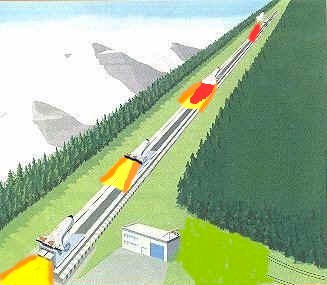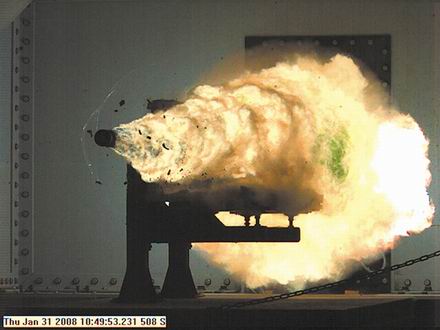Projectile space launch - the use of ground-based accelerators to help put payloads into orbit.
Putting things into orbit remains expensive. It's been persuasively argued that the dominant cost is labor, in expensive forms: recurring engineering.1 Why is this?

NASA staff inspect ... and inspect ....
Orbit-class rocketry involves exotic materials, unusual manufacturing techniques, and relatively low production rates. Low rates of production make achieving economies of scale difficult. Many technicians and engineers end up doing tasks that, if demand were higher, would be economically automated. Exotic materials aren't cheap, almost by the definition of "exotic". Most things we use in daily life and work are engineered with high safety factors (as much as 5x) to avoid liability lawsuits. Our everyday items are also often made with the cheapest materials that will satisfy the customer, and these are often the heavier materials. Doing without high safety factors entails frequent testing and inspection out of concern for failure of materials crafted to somewhere near the limits of their performance. Why not just go with higher safety factors? They usually impose a penalty in mass. And because of what's been called "the tyranny of the rocket equation,"2 more mass would mean much larger rockets, and more stages. Trying to make rocket launch cheaper in one category of expense just squeezes expense out into another category. Launcher design is a thicket of trade-offs. It's an unusually complicated thicket. They don't call it rocket science for nothing.
Note that it's recurring engineering. A big rocket launch has been compared to building an ocean liner, then scuttling it after it makes one ocean crossing. This observation has been taken as dictating reusability wherever possible. But does reusability make launch to orbit dramatically cheaper? The record so far isn't very encouraging.

First stage return - only 30% cheaper?
Air launch reuses the aircraft, but the one system currently in repeated use (the Orbital ATK Pegasus, launched while slung under a Boeing L-1011) isn't particularly cheap. The Space Shuttle was even more reusable -- only the external tanks were discarded. It wasn't cheap either. More recently, SpaceX is able to return lower stages and launch with them again. However, the chief executive of SpaceX has estimated the cost reductions at around 30%. This is not cheaper by a factor of three, or even two, as so many of us had hoped. SpaceX had already demonstrated dramatic cost reductions. But it got these before lower-stage reuse.
The earlier cost reductions at SpaceX appear to have come not from better technology (though there is some), but from two business decisions. One was to organize launcher production largely under a single corporate roof, which enables more "agile" engineering bureaucracy, rather than as a far-flung network of subcontractors as seen in the aerospace incumbents. The other decision was to gain some economies of scale by standardizing on an engine (the most value-added component) that can be used in clusters. Those are good practices. But they aren't new. This is how Russia became the low-cost leader in space launch. And with the uncertainties over whether upper stages can be economically returned, SpaceX may have reached the point of diminishing returns for cost reductions.

The L5 Society inspired work on electromagnetic launchers
Project Persephone looks in another direction: projectile space launch. In one form, people call this idea "space guns". In another, "mass driver." In any form, it puts most of the apparatus required for acceleration on the ground, where overall mass doesn't matter very much. Most of what gets put into orbit can be ruggedized for very high accelerations, so the loss is only in not being able to launch people or anything else very delicate.

Rocket exhaust: too much soot?
The recurring engineering costs required to orbit payloads using projectile space launchers should be far lower than those for rocketry, perhaps by an order of magnitude. 3 The global environmental impact should be lower as well. For example, by avoiding or minimizing rocket firings in the atmosphere, it should be possible to launch lots of cargo into orbit with much less degradation of the atmosphere by pollutants such as soot (black carbon), which has high global warming potential (GWP).4,5
Project Persephone's focus on aid and development projects in equatorial mountain regions is strongly motivated by the likelihood that these regions can be made ideal for projectile space launch. Of course, such regions also tend to be relatively undeveloped and energy-poor. Space launch tends to require expensive labor (recurring engineering costs?) from developed countries, and it's also quite energy-intensive. However, some schemes for projectile launch, such as the ram accelerator, could require relatively little energy per unit of mass orbited, and only very simple infrastructure requiring relatively little expert operation and maintenance.

Small hydro in Kenya
Communities in mountain equatorial regions should be able to provide most of the basic material and energy for launch. In particular, the ram accelerator shows promise for providing high accelerations from tubes that, with appropriate engineering6 can be made from materials (such as high-grade steel) that are far less exotic than many of those seen in high-performance aerospace applications. The energy from the byproducts of sustainable forestry, and from using off-peak electricity surpluses from small hydro, wind power? and geothermal energy should be more than adequate. If the crater of a dormant or extinct volcano considered as a launch point contains a crater lake, the same drilling equipment used to tap geothermal power might be used to bore a "pilot tunnel" from the crater to the base, for small hydro. Oil drilling equipment could be used initially; wider channels (though still as narrow as one meter) could be created with a tunnel boring machine. Development of such energy sources in candidate regions for local community use and for supplying their neighboring communities, should take precedence as a Project focus. The Project would help supply the needed equipment and expertise in exchange for promises of an adequate share of energy, if and when the time comes for projectile launch development.

Nice thought, but ....
There has been research, even relatively recently, on boosting partly air-breathing spacecraft up to supersonic speeds along more-or-less horizontal tracks, with a view toward eventually hosting human-rated launchers7. However, Project Persephone doesn't aim to launch people, which is inevitably expensive. Instead of relatively low horizontal acceleration as a prelude to hypersonic aerodynamic stages, it looks instead to sites for high-angle, very high acceleration launch from mountain slopes, particularly those of extinct or dormant stratovolcanoes near the equator, obviating the need for complex air-breathing propulsion stages.

U.S. Navy test of a railgun - smart munitions pushed to 2.4 km/sec?
A common objection to projectile space launch is that nothing of any complexity could survive it -- at best, it's thought that only bulk materials can be shipped. This isn't true. Complex unpiloted aerial vehicles have been designed that fold into a package formed as a standard 155 mm artillery round, demonstrating in tests that they can function after being subjected to 12,000 g accelerations.8 The payloads required for telebotic construction of exovivaria can be engineered to survive similar launch stresses, if necessary.
Another common objection to projectile space launch is that the vehicles would simply disintegrate in the lower atmosphere. In fact, it's been estimated that even low-mass projectiles exiting an accelerator at sea level could survive transit of the atmosphere with less than half of their mass devoted to cooling or ablative shielding.9. For larger projectiles at higher altitudes, the mass requirement for thermal protection has been estimated as low as 1% of total mass accelerated.

A more serious objection to projectile space launch from the Earth's surface is environmental: atmospheric shock waves. The shock wave from light gas gun launches at Lawrence Livermore was strong enough to kill nearby plant life. Endangered animal species, such the Andean Condor, could end up displaced from some habitats, and significantly disturbed in others. Sonic booms from the projectile could be very alarming and stressful to people even hundreds of kilometers away. Careful siting, timing and advance warning should ameliorate these problems to some extent. With an exit point from a volcano crater, perhaps a significant portion of the initial shock could be deflected upward; higher launch altitudes would tend to reduce shock intensity; and higher altitudes also correlate with remoteness of location. The environmental impact from strong shock waves is an important criterion for narrowing the choice of sites, and will very likely be an ongoing research topic even after likely sites are chosen for preliminary development.
References
- The Space Review, "Space and (or versus) the environment", http://thespacereview.com/article/1395/1
- "Studies on Ground Based Accelerators", Gerry Flanagan, 2011
1 "Why Are Launch So High?", Peter A. Taylor, March 2000 (last major update September 2004) ⇑
2 "The Tyranny of the Rocket Equation", Don Petit, NASA, 05.01.12 ⇑
3 "Ground-based, hypervelocity accelerators for low-cost delivery of large numbers of small, high-g tolerant payloads to LEO are a near-term technology that can provide significant payoff for a relatively small technology investment." NASA, April 2012. Launch Propulsion Systems Roadmap: Technology Area 01, p.2 ⇑
4 Adam Mann, ""Space tourism to accelerate climate change", 22 October 2010, Nature, doi:10.1038/news.2010.558 ⇑
5 Geophysical Research Letters, v.37, 2010, "Potential climate impact of black carbon emitted by rockets", Martin Ross, Michael Mills, Darin Toohey, doi:10.1029/2010GL044548 ⇑
6 "Gasdynamic Operation of Baffled Tube Ram Accelerator in Highly Energetic Mixtures", A.J. Higgins, C. Knowlen, C.B. Kiyanda, Submitted to: 20th International Colloquium on the Dynamics of Explosions and Reactive Systems. http://www.galcit.caltech.edu/~jeshep/icders/cd-rom/EXTABS/178_20TH.PDF ⇑
7 "First Stage of a Highly Reliable Reusable Launch System", Kurt J. Kloesel, Jonathan B. Pickrel, Emily L. Sayles, Michael Wright, Darin Marriott, Leo Holland, Stephen Kuznetsov, AIAA 2009-6805. http://pdf.aiaa.org/preview/CDReadyMSPACE09_2074/PV2009_6805.pdf ⇑
8 "Flyer Assembly", Patent No 6,392,213 B1 Issued May 21, 2002 http://www.metisdesign.com/docs/wasp_patent.pdf ⇑
9 http://www.cs.cmu.edu/afs/cs/usr/mnr/st/std027, http://www.tbfg.org/papers/Ram%20Accelerator%20Technical%20Risks%20ISDC07.pdf ⇑
Further Reading
- "The Blast Wave Accelerator - Feasibility Study", D. Wilson. Z. Tan, CP 552?, Space Technology and Applications International Forum-2001, edited by M. S. El-Genk

